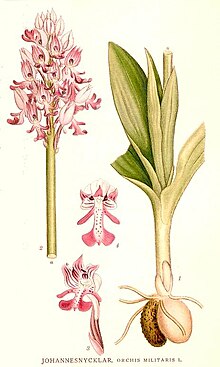List of taxa named after human genitals
This a list of species, genera, and other biological taxa named after human genitals.

Background
- Pubescens. The word originates from the Latin pubes, "adult, full-grown";[1] "genital area, groin"[2] (e.g., Pubis); "the down or soft hair which begins to grow on young persons when they come to the age of puberty".[3] The use of the term in biology to refer to hairiness or soft down is recorded since 1760 for plants and since 1826 for insects.[1]
- Vaginalis. The common specific name is derived from the Latin vagina, originally meaning "sheath, scabbard, covering; sheath of an ear of grain, hull, husk."[4] The specific epithet may refer to a sheathed trait or habit of an organism (e.g. Alysicarpus vaginalis), or may refer to resemblance/relation to the vagina (e.g. Gardnerella vaginalis)[5]
Plants

Families
- Orchidaceae. The type genus is Orchis, whose name comes from the Ancient Greek ὄρχις (órkhis), literally meaning "testicle", because of the shape of the twin tubers in some species of Orchis.[6]
Genera
- Amorphophallus[7]
- Clitoria[8]
- Orchis[6]
Species
- Alysicarpus vaginalis
- Baumea vaginalis
- Chenopodium vulvaria[9]
- Festuca vaginalis
- Pontederia vaginalis

Varieties
Fungi

Orders
Families
Genera
- Phallus[10]
Species
Animals
Genera
- Phallichthys. The genus name literally means "phallus (penis) fish",[12] from the Greek phallos meaning "penis" and ichthys meaning "fish",[13] referring to the "comparatively huge" gonopodium, the modified anal fin used for copulation.[12]
Species
Subspecies
- Muntiacus muntjak vaginalis
Animal fossils
- Scrotum humanum
References
- ^ a b Harper, Douglas. "pubescence (n.)". Online etymology dictionary. Retrieved 29 August 2022.
- ^ Harper, Douglas. "pubis (n.)". Online etymology dictionary. Retrieved 29 August 2022.
- ^ Valpy, Francis Edward Jackson (1828). An etymological dictionary of the Latin language. London: Printed by A.J. Valpy, sold by Baldwin and Co. p. 377. Retrieved 29 August 2022.
- ^ Harper, Douglas. "vagina (n.)". Online etymology dictionary. Retrieved 3 January 2023.
- ^ Gmelin, Johann Friedrich (1789). Systema naturae per regna tria naturae : secundum classes, ordines, genera, species, cum characteribus, differentiis, synonymis, locis (in Latin). Vol. 1, Part 2 (13th ed.). Lipsiae [Leipzig]: Georg. Emanuel. Beer. p. 705.
- ^ a b Hyam, R. & Pankhurst, R.J. (1995). Plants and their names : a concise dictionary. Oxford: Oxford University Press. p. 356. ISBN 978-0-19-866189-4.
- ^ Quattrocchi, Umberto (1999). CRC World Dictionary of Plant Names: Common Names, Scientific Names, Eponyms, Synonyms, and Etymology. CRC Press. p. 118. ISBN 9780849326738.
- ^ Fantz, Paul R. (2000). "Nomenclatural Notes on the Genus Clitoria for the Flora North American Project". Castanea. 65 (2): 89–92. JSTOR 4034108.
- ^ Blackledge, Catherine (2020). Raising the Skirt: The Unsung Power of the Vagina. Hachette UK. ISBN 9781474615846.
- ^ Schaechter E, Wilson N. "Modern English Translation of Hadrianus Junius' 1564 work on Phallus hadrianii". A mycological voice from the past. Archived from the original on 2013-01-19. Retrieved 2010-10-25.
- ^ Vaillant, Sébastien (1727). Botanicon Parisiense (in Latin). Leide & Amsterdam: J. H. Verbeek and B. Lakeman. OCLC 5146641.
- ^ a b Hellweg, Mike. "Meet the Merry Widows: The Genus Phallichthys". Tropical Fish Hobbyist Magazine. Archived from the original on 26 August 2023. Retrieved 26 August 2023.
- ^ "Phallichthys amates (Miller, 1907)". FishBase. Archived from the original on 27 August 2023. Retrieved 27 August 2023.












